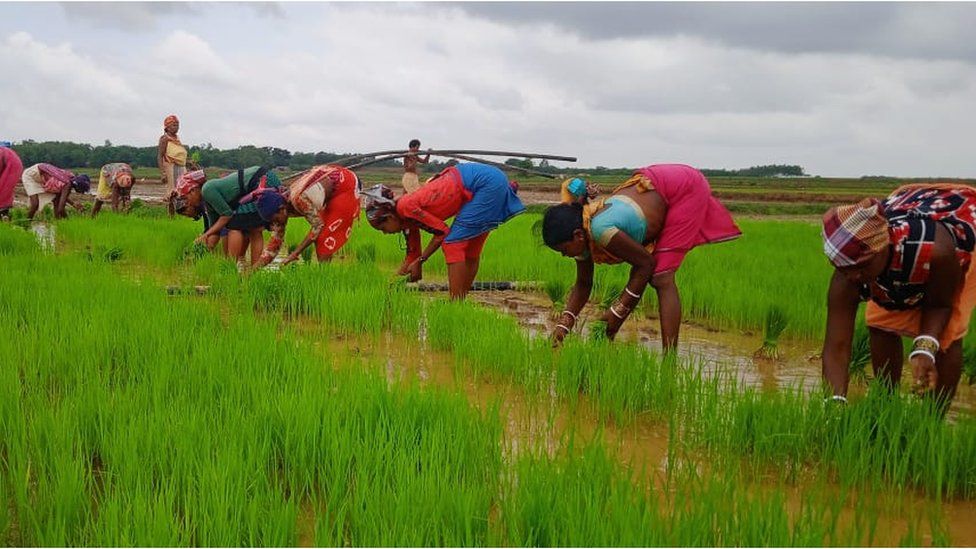Tags
Back to the future for India’s rice farmers

Varsha Sharma has been through some turbulent years on her small farm in the mountainous state of Himachal Pradesh, in northern India.
For more than a century her family have been rice farmers, but erratic rainfall and water being diverted for industry have made cultivating rice more difficult.
Seven years ago she switched to a hybrid rice variety and to growing apples, but that just caused fresh problems.
The hybrid rice variety promised increased production, but needed a lot of additives, which she says damaged the soil.
“We destroyed our soils by adding chemicals and fertilizers,” she says.
So in 2018 she switched again, this time experimenting with red rice, a variety which has a long history in Himachal Pradesh, but has dwindled as farmers have switched to modern varieties.
Red rice has attractive qualities. It is hardy and grows well without fertiliser and other chemicals. Research also shows it has nutritional benefits over white rice.
But perhaps for farmers the biggest attraction is that it sells well.
“Red rice fetches a good price, ranging between $3 and $4 per kilo in the retail market, as it completely organic. This has helped many farmers like me,” says Ms Sharma.
The government of Himachal Pradesh wants to expand the production of red rice, increasing its area under cultivation to 4,000 hectares (10,000 acres).

Red rice is not the only traditional variety being promoted.
In West Bengal, the largest rice producing state in India, almost half of its arable land is under rice cultivation.
It is home to more than 5,000 varieties of rice, but the majority are no longer grown.
“They [farmers] are only thinking about increased production, hence are switching to hybrid varieties,” says Anjan Kumar Sinha, the founder of the Socio-Environmental Welfare Society (ARSWS), which promotes conservation and the restoration of biodiversity.
He says that farming hybrid rice varieties can be expensive.
“When hybrid seeds are used, the demand for pesticide increases and the costs go up in an unsustainable way.
“Indigenous rice seed varieties have adapted to local ecologies and can resist drought and floods. We have varieties of rice seeds in India which can grow without water,” says Mr Sinha.
Farmers who join his organisation get a kilo of seeds free, enough to produce up to 60kg of rice. In return the farmers have to return a kilo of seeds.
“These varieties may play a vital role in sustainable agriculture in drought prone regions,” he adds.
Rice is widely consumed and grown in India and it is the world’s biggest exporter of the grain.
But in July, to tame surging domestic prices after heavy rains hurt crops, the Indian government banned the export of non-basmati white rice.
This came after Russia withdrew from a deal guaranteeing the safe passage of Ukrainian grain, putting more pressure on global food supplies.

Shankar Patnaik, who is also a farmer and seed conservationist, says that farmers “became greedy” and started growing rice from hybrid seeds to boost production.
“We used lot of urea and fertilizers which destroyed our soil. Also now very few farmers are using traditional seeds to grow rice,” he says.
Mr Patnaik has a collection of 500 rice varieties and is experimenting with many of them on his 14 acres of land.
“There are several indigenous rice varieties that can have higher yields but their potential is not fully explored. Even without application of chemical fertilizers one can get a good yield. But generally, people consider these as low yielding varieties and don’t pay much attention,” says Mr Patnaik.
As well as experimenting with varieties, Mr Patnaik is working on growing methods that need less water.
In particular he uses the alternate wetting and drying (AWD) method. In that technique famers flood fields, allow them to drain for a few days, and then flood them again.

This is one of the processes promoted by India’s Centre for Sustainable Agriculture (CSA), an organisation that works with farmers to make farming more sustainable.
“Rice is highly water-consuming crop. It’s grown in stagnant water and consumes about 5,000 litres if water per kg of rice,” says GV Ramanjaneyulu, executive director of the CSA.
He says bacteria in rice ponds emit methane, and flooding damages the soil structure, and can make it more salty.
He says there are several ways of growing rice with less water, but at the moment they need more support.
“There are no proper campaigns or training on these methods and no incentive for farmers to make a shift,” says Mr Ramanjaneyulu.
“Many of the current incentive systems like fertilizer subsidy, free power, canal irrigation, minimum support price and procurement, all work against the interest of farmers to shift towards more sustainable production,” he adds.
One farmer who has embraced a new technique is Prema Devi from Farsali Malde, a village in the northern state of Uttarakhand.
“Most of the people from the village are farmers but with major climatic changes we started facing a lot of problems. Our crops got destroyed because of unseasonal rains or scarcity of water,” she says.
So, in 2021 she started to reduce the number of rice seeds she planted.
Rice saplings are grown in nursery beds and are transferred to main field after 12 to 14 days, where they are planted six to eight inches apart.
“The spacing between each plant gives them more oxygen, and minimises the competition between plants for nutrients and sunlight,” says Ms Devi.
She says the system has doubled her rice production to 100kg a year.
“It was not easy for us to believe that a simple change in technique was all we needed,” she says.
https://www.bbc.com/news/business-66323991Published Date: August 15, 2023






